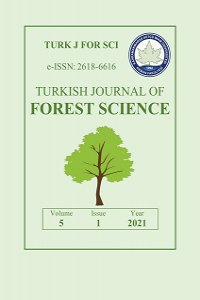KENTSEL ALANLARDA YOĞUN GÖÇLERİN SEBEP OLDUĞU KÜLTÜREL VE MEKANSAL DEĞİŞİKLİKLER; HATAY, TÜRKİYE'DEN BULGULAR
Kitlesel göç durumunda, çoğunlukla mülteciler göç ettikleri ülkenin kültürüne ve yaşam tarzına kendi kültürlerini ve yaşam tarzlarını sentezlemeye çalışmaktadırlar.2011 yılında Suriye'deki iç savaş başladığından itibaren, Türkiye'nin hemen her bölgesi Suriyeli mültecilerin yoğun göçüne maruz kalmıştır . Suriye sınırındaki şehirlerden biri olan Hatay’a, yaklaşık 500.000 mülteci kabul etmiş ve bu durum şehir yapısında önemli mekansal ve sosyal değişimlere neden olmuştur. Mülteciler birçok çalışma alanında Hatay'da ucuz işgücü yaratmış, bu da o bölgede yaşayan ve çalışan vatandaşların gelirini azaltarak ekonomik sorunlara yol açmıştır. Kiralardaki artış ve nüfusun merkezden şehrin çeperine yayılması ciddi kentsel sorunlara yol açmaktadır. Bu çalışmanın amacı, kontrolsüz göçün kentin zaman içindeki kültürel, ekonomik ve mekansal değişimini nasıl etkilediğini analiz ederek haritalamaktır (2009-2019). Çalışma kapsamında uzaktan algılama teknikleri ile elde edilen Landsat uydu görüntüleri, görüntü işleme yazılımında işlenmiş; sosyal, ekonomik, kültürel ve kentsel değişimler çeşitli görüntü sınıflandırma yöntemleri uygulanarak tespit edilmiştir. Kent kimliği, imar, tarihi değerlerin yok edilmesi, yöre halkının bölgeden yabancılaşması gibi önemli konular dikkat çekmektedir. Örneğin dükkanlardan yükselen Arap tabelaları ve Arap müziği sokakları küçük bir Suriyeli gibi gösteriyor. Bu gelişmeleri yakından takip eden ve şimdi Suriye gerçekliğini kabul eden vatandaşlar, bir zamanlar İngiliz isimlerinin şehirdeki mağazalara yerleştirilmesinden şikayet etti, şimdi Arapça tabelaların arttığına dikkat çekiyor.
Anahtar Kelimeler:
Göç, kentsel değişim, coğrafi bilgi sistemleri
CULTURAL AND SPATIAL CHANGES CAUSED BY INTENSIVE MIGRATION IN URBAN AREAS; EVIDENCE FROM HATAY, TURKEY
In the case of mass migration, mostly refugees try to synthesize their own culture and lifestyle into the culture and lifestyle of the country in which they migrate. Since the civil war in Syria started in 2011, almost every region of Turkey has been exposed to intense migration of Syrian refugees. Hatay, one of the cities on the Syria border, has received approximately 500.000 refugees which causes significant spatial and social changes in city structure. Refugees have created cheap labor in Hatay in many work areas, which caused economic problems by reducing the income of citizens living and working in that region. The increase in rents and the spread of the population from the center to the periphery of the city led to serious urban problems. The aim of this study was to examine and create a number of maps to indicate how uncontrolled migration affects the cultural, economic and urban change of the city over time (2009-2019). Landsat satellite images, which are obtained by remote sensing techniques, were processed in image processing software; therefore social, economic, cultural and urban changes were discussed with the result data generated by applying several image classification methods. Important issues such as urban identity, zoning, destruction of historical values, alienation of local people from the region attract attention. For example, Arab signs rising from shops and Arab music make the streets look like a small Syrian. Citizens who follow these developments closely and now accept the reality of Syria have complained that British names were once placed in stores in the city, now points out that Arabic signboards have increased.
Keywords:
Urban Change, Immigrants, geographic information systems,
___
- Allen, R., Slotterback, C. S. (2017) Building immigrant engagement practice in urban planning: The case of Somali refugees in the Twin Cities, Journal of Urban Affairs, DOI: 10.1080/07352166.2017.1360745
- Al-Tal, R. S., Ghanem, H. H. A. (2019) Impact of the Syrian crisis on the socio-spatial transformation of Eastern Amman, Jordan. Frontiers of Architectural Research (2019) 8, 591-603.
- Andria, M., (2005) Environmental conflict between refugees and host communities. School of development studies. J. Peace Res. 42 (No.3), Pp329–346.
- BBC, British Broadcasting Corporation. “The number of Syrians living in camps in Turkey” Accessed: 04.11 2019 https://www.bbc.com/turkce/haberler-turkiye-49150143
- Crisp, J., (2003) No Solution in Sight : the Problem of Protracted Refugee Situations in Africa. Evaluation and Policy Analysis Unit, UNHCR. (Online) Working Papers. Center for Comparative Immigration Studies, UC San Diego. http://escholarship.org/uc/ item/89d8r34q.
- Gülgün, B., Güney, M. A., Aktaş, E., & Yazici, K. (2014) Role of landscape architect in interdıscıplinary planning of sustainable cities. Journal of Environmental Protection and Ecology, 15(4), 1877–1880.
- Hatay Zafer.“The reason for the increase in the industrial area” Accessed: 13.11 2019 https://www.hatayzafer.com.tr/hatay-ekonomisinin-lokomotifleri-3/.
- Kahl, Colin, (1999) States, Scarcity, and Civil Strife in the Developing World. Institute of War and Peace Studies Columbia International Affairs Online. April 1999. Accessed: 13.11.2019. Available: http://0www.ciaonet.org.bianca.penlib.du.edu:80/wps/kac02/-index.html, Accessed : 13.11.2019.
- Kalaycı Önaç, A., Birişçi, T. (2019) Transformation of urban landscape value perception over time: a Delphi technique application. Environmental Monitoring and Assessment. 191, 741, doi.org/10.1007/s10661-019-7935-9
- Nufusu. “Population of Hatay” Accessed: 20.10.2019. https://www.nufusu.com/il/hatay-nufusu Refugees Association. “For the number of registered refugees in Turkey”. https://multeciler.org.tr/eng/. Accessed: 13.11 2019
- Seethaler-Wari, S. (2018) Urban Planning for the Integration of Refugees: The Importance of Local Factors. Urban Planning (ISSN: 2183–7635), Volume 3, Issue 4, Pages 141–155. DOI: 10.17645/up.v3i4.1696
- Thompson, S. (2000) Chapter 13: diversity, difference and the Multi-Layered city. In: Freestone, R. (Ed.), Urban Planning in a Changing World- the Twentieth Century Experience. Taylor & Francis, pp. 231e245.
- Toros, A. (2008) Sorunlu Bölgelerde Göç, Global Strateji Enstitüsü, Ankara.
- UNEP Division of Environmental Policy Implementation, (2005) Impacts of Refugees and Internally Displaced Persons on the Environment in Tanzania. www.unep.org/depi/programmes/emergencies.html, Accessed date: 14.11.2019.
- United Nations High Commissioner for Refugees. ”For the number of registered refugees in World”. Accessed: 04.11 2019 http://reporting.unhcr.org/population
- VOA, Voice of America. “Information on the camp and asylum problem” Accessed: 04.11 2019 https://www.amerikaninsesi.com/a/dunya-genelinde-multeci-sayisinda-rekor-artis/4965380.html
- Yayın Aralığı: Yılda 2 Sayı
- Başlangıç: 2017
- Yayıncı: Kahramanmaraş Sütçü İmam Üniversitesi
